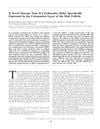Type II Keratins Are Phosphorylated on a Unique Motif During Stress and Mitosis in Tissues and Cultured Cells
June 2002
in “
Molecular Biology of the Cell
”
TLDR Type II keratins are uniquely phosphorylated during stress and mitosis, affecting their structure and function.
The study explored the phosphorylation of type II keratins (K4, K5, K6, and K8) on a conserved LLS/TPL motif during stress and mitosis, revealing its significance in keratin solubilization and filament reorganization. This phosphorylation, mediated by proline-directed kinases like p38 MAP kinase, was observed in conditions such as mitosis, apoptosis, and stress, including in psoriatic skin and squamous cell carcinoma. The research underscored the motif's role in keratinocyte stress response and mitogenic signaling, offering insights into the pathology of skin-related diseases.

